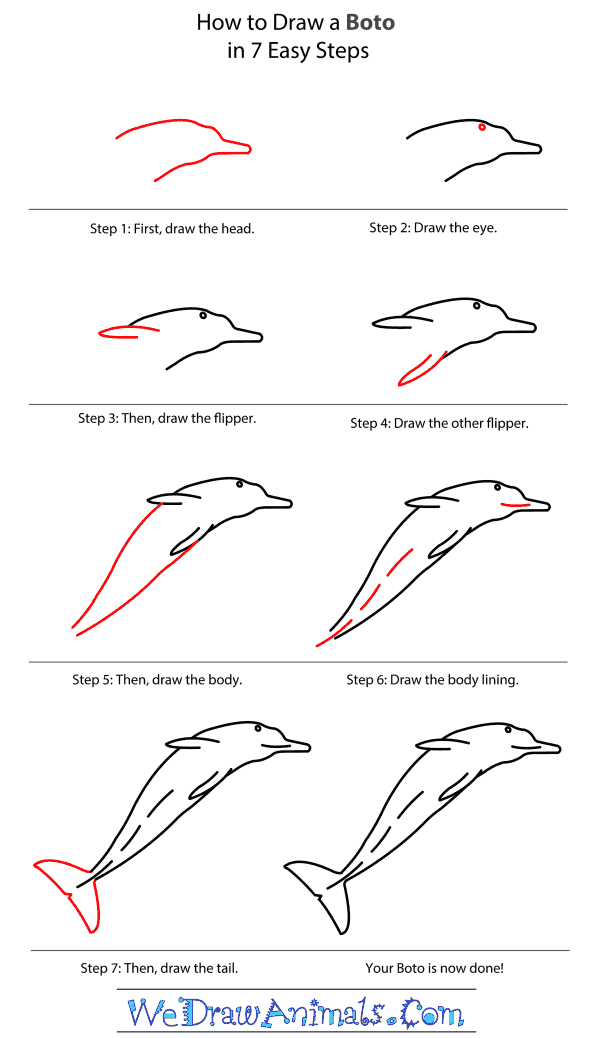In this quick tutorial you'll learn how to draw a Boto in 7 easy steps - great for kids and novice artists.
The images above represent how your finished drawing is going to look and the steps involved.
Below are the individual steps - you can click on each one for a High Resolution printable PDF version.
At the bottom you can read some interesting facts about the Boto.
Make sure you also check out any of the hundreds of drawing tutorials grouped by category.
How to Draw a Boto - Step-by-Step Tutorial
Step 1: First, let us start by drawing the outline of the Boto’s head using curved lines. Draw the rounded snout of the dolphin as shown in the image.
Step 2: Draw a small circle near the outer line of the head for the eye of the Boto dolphin.
Step 3: Draw one pectoral fin on the front side of the dolphin’s body using straight lines and a curve to round off the tip.
Step 4: Draw the other pectoral fin of the Boto along the other side of the body using slanting lines and a curved line to round off the tip.
Step 5: Draw the conical body of the Boto using two gently curved lines.
Step 6: Draw a dashed line along the lower body of the dolphin. Draw a line along the snout of the dolphin to show the jaw separation.
Step 7: Draw the tail of the Boto using two curved lines and then draw the edge of the tail using a straight line. Add a small curve to the edge of the tail to show the tail groove. After you finish your drawing, you can color it.
Interesting Facts about the Boto (Inia goeffrensis):
The Amazon River dolphin (inia goeffrensis), also called the Boto, is the largest of the freshwater dolphins. The Boto is found in South America, from the Amazon River delta to the Orinoco and other rivers, tributaries and lakes. It is of medium size, with a thick, heavy body and a prominent domed forehead; the male grows to about 7 feet and the female to about 5.5 feet. It has no dorsal fin but has unusually large flukes and flippers to help it maneuver in shallow water. The boto’s neck bones are not fused together, so it is able to angle its neck 90 degrees downward or sideways and move its head with great flexibility from side to side. As it scans, the Boto emits a clearly audible sound for echolocation of its prey.
Did you know?
- The Boto gets its name from the Portugese “boutu vermelho” (“red dolphin”) for its lovely color, which can range depending on its age from a soft, grayish-pink to a bright, vivid pink; it gets paler as it ages.
- Most Boto calves are born between July and September after a 9- to 12-month gestation, weighing about 15 pounds and measuring about 32 inches long at birth.
- This dolphin has stiff hairs on its long beak, which are thought to provide a sense of touch as it roots for food—such as Amazon catfish—in the mud.
- South American Indians once believed that anyone who killed a Boto would bring misfortune and bad luck to himself and his village.
- The Boto dolphin also eats piranha!
Usually seen alone or in pairs, the Boto is friendly and curious, often approaching boats. The South American taboos against killing the Boto once provided it with protection, but since new settlers arrived and settled along the river banks, large numbers of the mammal have been killed. Leather is made from Boto skin and Boto fat is used for cooking. Several hundred Botos have been captured alive and placed in aquariums for human viewing. Out of the almost 100 Botos taken by the United States for various aquarium displays, fewer than 20 were able to adapt to life in captivity.








